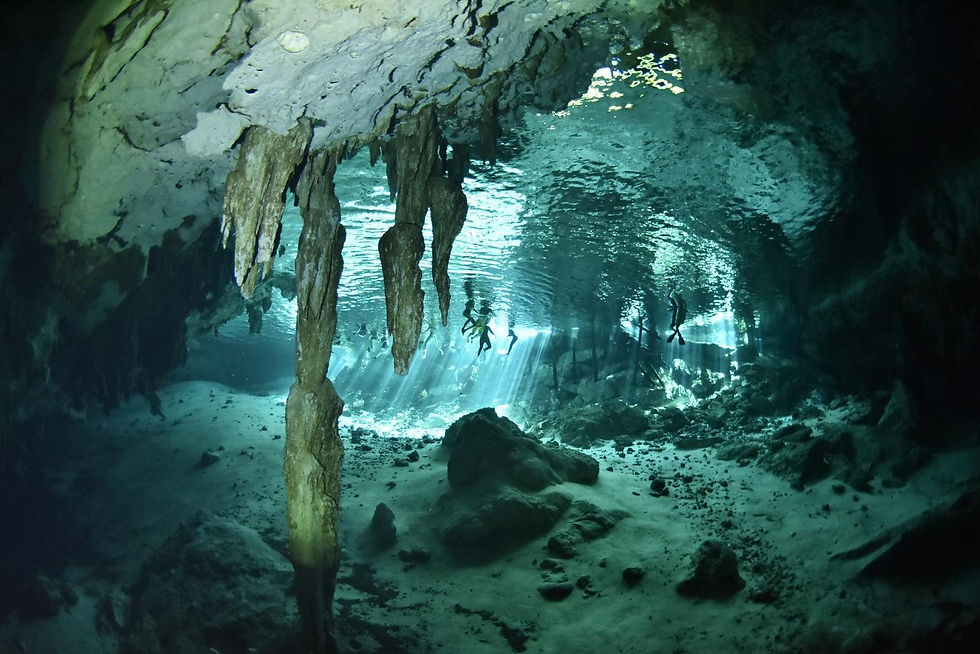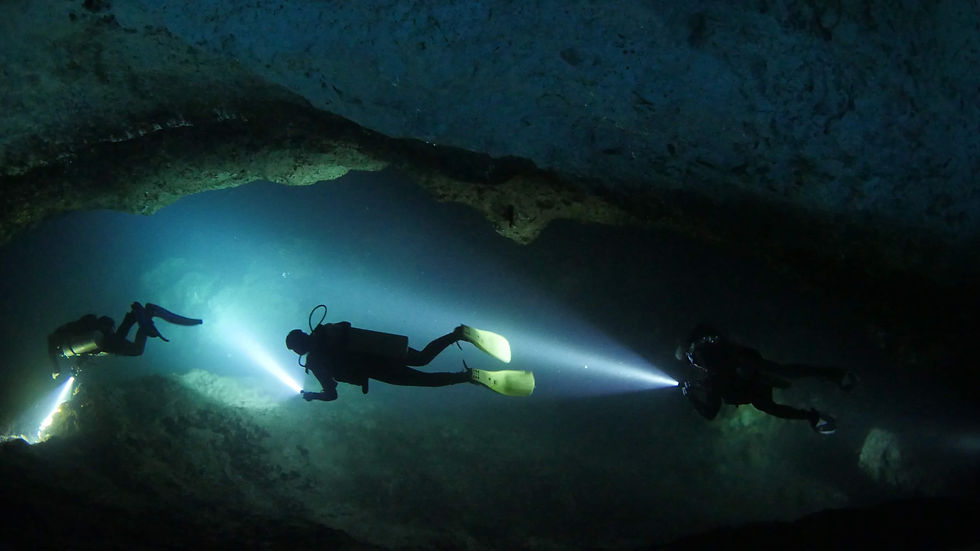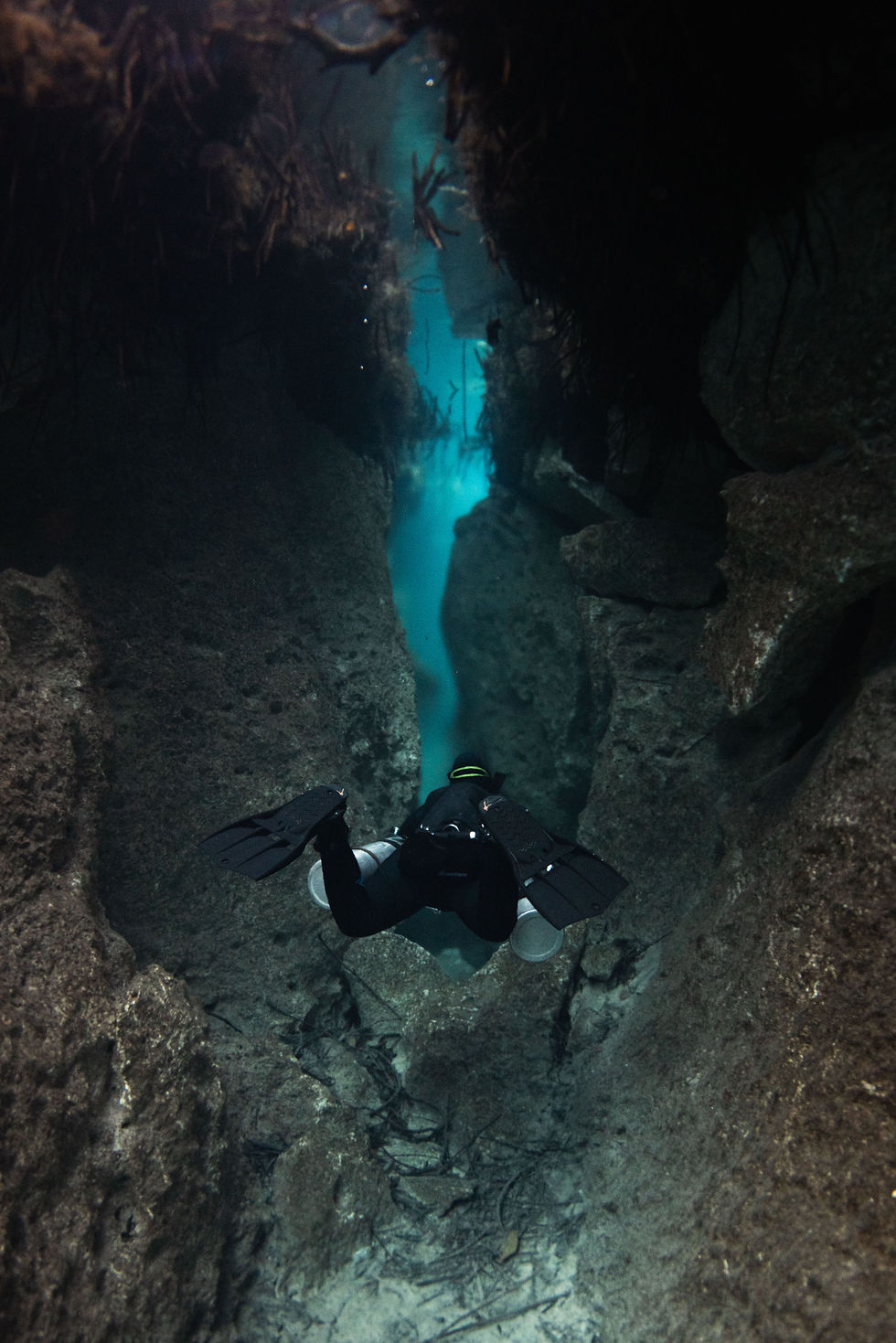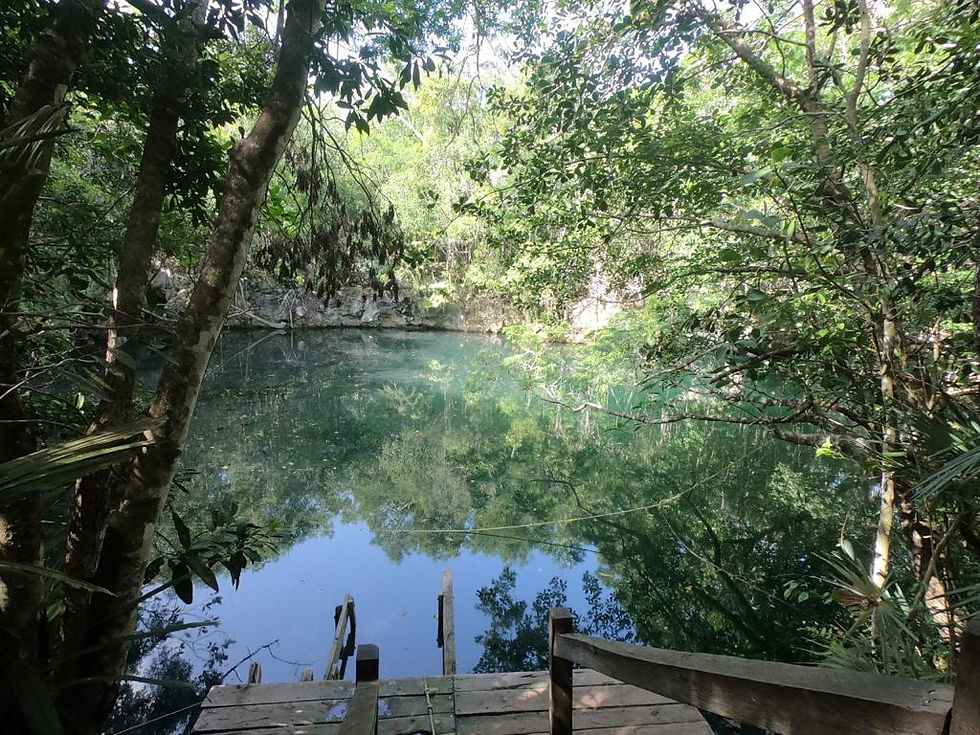First time diving the cenotes around Tulum, which ones should I visit ?
- marc green
- Jul 20
- 7 min read
Updated: Sep 22
The cenotes around Tulum are suitable for certified divers but have different levels of difficulty. Here we are going to look at in what order you should visit them.

It's crucial to keep in mind that you must be a certified diver to enter the cavern (an Open Water Diver certification suffices). Nonetheless, to truly appreciate everything these cenotes offer, you'll need excellent buoyancy skills due to the presence of numerous magnificent stalactites, stalagmites, and impressive columns that are millions of years old, which you definitely want to avoid getting stuck on!
Cenote Dos Ojos
Diving in this cenote is incredibly simple and ideal for your first cavern dive. It features spacious passages and chambers, lacks any current, and is quite shallow at just 8m/26ft. You'll be captivated by the stunning light entrances and enjoy unparalleled visibility, exceeding 100m/330ft. The water is so clear and refreshing that it feels as though you're flying.
Dos Ojos is a large cenote, requiring at least two tanks to explore the entire cavern. There are two lines to follow. One is known as “The Barbie line,” named for the Barbie doll attached to it. This is considered the easiest dive due to its numerous light entrances. The other is the “Bat Cave,” which is slightly darker. But don't worry! You will always have a light, and the water is so clear that you can see EVERYTHING! The combined distance of the two lines is about 500 meters.
Despite the intense heat in the jungle, wearing a 3mm wetsuit is advisable, or a 5mm wetsuit if you are prone to feeling cold. The water remains at a temperature of 24°C/75°F throughout the year.
Make sure to stop by the shop "Fisheye" before the day ends. Henry, the owner, is among the most skilled artists in the region and has created some amazing t-shirts, mugs, stickers, hats, and the finest souvenirs you can bring back from your dive: underwater photos and videos!

Cenote Chac Mool
These cenotes form a network of submerged tunnels and flooded chambers that offer a breathtaking visual experience. While they might appear as mere water-filled holes in the ground from above, the enchantment truly starts once you dive in.

At Cenote Chac Mool, you can marvel at various rock formations and stunning light displays.
The name “Chac Mool” is derived from an ancient Mayan sculpture, translating roughly to “great red jaguar.” Chac Mool is also the name of a Mayan rain and lightning deity, adding an aura of mysticism and tradition to the experience of visiting the cenote.
This Cenote is renowned for its halocline phenomenon, which happens when saltwater and freshwater converge, producing a visual effect that looks like a layer of air beneath the water. In certain areas, the upper freshwater is so transparent that divers appear to be floating in the air. Here we do two dives, first is called the Kulkulkan route, famous for its light rays and photography opportunities. After lunch the second dive starts in cenote Little brother and traverses through an air dome then to Cenote Chac Mool, finishing back at Little Brother.
Casa Cenote
This place is ideal if you need a refresher having not dived for a while. But also an excellent dive in its own right.

Casa Cenote is a unique cenote diving experience as it lies beneath a dense mangrove
Casa Cenote offers a distinctive diving experience, as it is located beneath a thick layer of mangroves. The emerald green waters stand out against the white sandy floor, where light reflections produce breathtaking colour spectrums. This cenote dive is both fascinating and visually stunning.
layer. The emerald green waters contrast beautifully with the white sandy bottom, where light reflections create stunning color spectrums. This cenote dive is both intriguing and visually captivating.
At Casa Cenote, you'll observe the captivating blend of saltwater and freshwater called halocline. A phenomenon occurring at the emergence of the world's longest underwater cave system.
Underwater photography will delight marine life enthusiasts, with schools of young tarpon , blue and red crabs, and various colourful fish inhabiting the area. The fortunate might even catch a glimpse of the resident crocodile, the protector of Casa Cenote.
This is the most vibrant cenote diving experience in our schedule and is your best opportunity to dive beneath mangroves.


Cenote The Pit
My personal favourite cavern dive in the area.

Exploring Cenote The Pit is a must-do experience for numerous divers. This remarkable deep dive adventure makes the journey to the Riviera Maya truly worthwhile.
Cenote The Pit is a geological treasure located in Mexico's Riviera Maya, approximately a 15-minute drive North of Tulum. It is part of the Dos Ojos Cenote Park, which contains numerous cenotes that form the Sac Actun system, the world's longest underwater cave system, with over 364 kilometers of explored tunnels.
The Pit, true to its name, is a vast and deep cenote that appears to be a bottomless abyss. It stands as one of the deepest cenotes in the area, reaching a depth of approximately 40 meters.
This depth suggests that the cenote dive is appropriate for divers who are experienced and possess at least an Advanced Open Water Certification.
The water consistently stays at a cool 26°C throughout the year, requiring a wetsuit to avoid feeling chilly.
The Pit Cenote, similar to numerous cenotes in Mexico's Yucatan Peninsula, originated from a natural geological process. The peninsula consists of porous limestone, and cenotes form when the limestone bedrock collapses, revealing the groundwater below.
Over millennia, slightly acidic rainwater seeped through the porous limestone, creating underground rivers and caverns. This ongoing water erosion gradually undermines the rock's structure. Ultimately, the ceilings of these caverns become so fragile that they collapse, leading to the formation of sinkholes or cenotes.
For The Pit Cenote, the limestone bedrock collapsed, forming a deep, circular sinkhole that revealed the groundwater below. This natural occurrence resulted in the stunning cenote, renowned for its clear waters and remarkable depth.

One of the most visually unique and thrilling aspects of scuba diving at Cenote The Pit is the visual effect created where the saltwater and freshwater layers converge.
This phenomenon, called a halocline, occurs when less dense freshwater from rain or rivers floats above denser saltwater.
When these two distinct water densities converge, they form a visible boundary known as a halocline, where the waters do not mix right away. This boundary can lead to a distorted underwater view and produce a cloudy or hazy effect because of the different refractive indexes of the two water types.
This phenomenon can create the appearance of a cloud-like layer or distortion in the water, and in Cenote El Pit, you’ll encounter it at approximately 12 meters deep.
Beyond that, at around 27 metres, Cenote The Pit, has a cloud-like layer of hydrogen sulfide.
This cloud or fog-like layer, is the result of hydrogen sulfide and other gases, which occur in some cenotes due to the decomposition of trees, leaves, and other organic matter that fall in from the jungle outside.
Bacteria breaking down the organic materials produce hydrogen sulfide gas, creating a cloudy appearance in the lower depths of the cenote. This cloud can give an otherworldly appearance of fog, mist or smoke.
This layer doesn’t pose a threat to divers or swimmers. Even though the cloud might resemble fog, it is harmless to humans. Divers who explore cenotes like Cenote The Pit or Cenote Angelita can pass through these layers without any risk.
In fact, the presence of the Halocline Layer in these cenotes adds to the allure and uniqueness of these incredible dive sites, offering a surreal experience for divers exploring these natural formations.
Cenote Angelita
This dive site is a must-visit for advanced divers seeking something unique. Its name translates to "little angel" in English, which perfectly captures the enchanting nature of this dive location. The journey begins with a short walk through the jungle to reach the large, secluded cenote. Simply put, this cenote plunges straight down to 100 feet. The upper half consists of fresh water with unlimited visibility, while the lower half is salt water, separated by a mystical hydrogen sulfate layer. This layer appears as a dense cloud from above and a strangely colored hue from below. Dive lights are essential if you plan to reach the bottom. Few dives in the world offer the experience of diving through clouds at 100 feet while seeing trees, but this site does. The cenote's deepest point is 120 feet, so ensure you have the appropriate gases in your tanks and, more importantly, the right guide to provide the safest and most rewarding dive possible.

To participate, you need to be certified as an Advanced Diver and have completed at least 20 dives. A distinctive aspect of this dive is the hydrogen sulfide layer that divides the fresh water from the salt water beneath. This intriguing cloud appears at around 100 feet (30 m) and extends down to 110 feet (34 m). We will descend to approximately 110 feet (34 m). It's an indescribable experience that you must witness firsthand!
Cenote Car Wash AKA Aktun Ha
Carwash Cenote, also referred to as Aktun Ha, which means “water cave” in Mayan, got its name from taxi drivers who once cleaned their cars in this cenote.
An expansive, lively pool features a stunning underwater garden filled with green algae and tall water lilies, which are highly favored by photographers. Observe the swirling schools of fish, turtles, and even the occasional small crocodile.
Massive dark structures await scuba divers inside. The speleothems are darkened by tannic acid, which once flowed through the system and continues to do so during heavy rain. From within the cavern, one can witness the breathtaking sight of fallen trees silhouetted against the bright entrance.
This cenote is an excellent spot for non-divers to unwind and snorkel. It features areas for lounging or sitting, walkways for strolling along the jungle's edge surrounding the cenote, platforms for jumping, and a small café.

In the downstream area of the cave from Cenote Car Wash in Mexico, there's a room called the Chamber of the Ancients. It's believed that the prominent triangular rock in the foreground, which contains charcoal, was utilized for cooking 11,000 years ago.
Cenote Dream Gate
When exploring Cenotes in the Yucatan Peninsula, most people envision a particular image. Cenote Dreamgate likely matches that vision of a Cenote the best. Nestled amidst vibrant greenery, deep within the Mayan jungle, this Cenote is located at the heart of a surface collapse. Steep stairs descend into the collapse, reaching the water level and providing access to this extraordinary and awe-inspiring dive.

Cenote Dreamgate is renowned as a cavern dive that closely resembles true cave diving. Many divers consider it their preferred cavern dive. Some even decide to pursue their cavern or cave diving certification after experiencing a dive here. In this blog, we discuss all the essential details about Cenote Dreamgate and what to anticipate from a Cenote dive at this enchanting location.

Here is a video of one of our dives in Dream Gate.
Keep a lookout for part 2 of this blog, which will cover the more advanced and off the beaten track cenotes. dives you should do after you have done these ones.




Comments